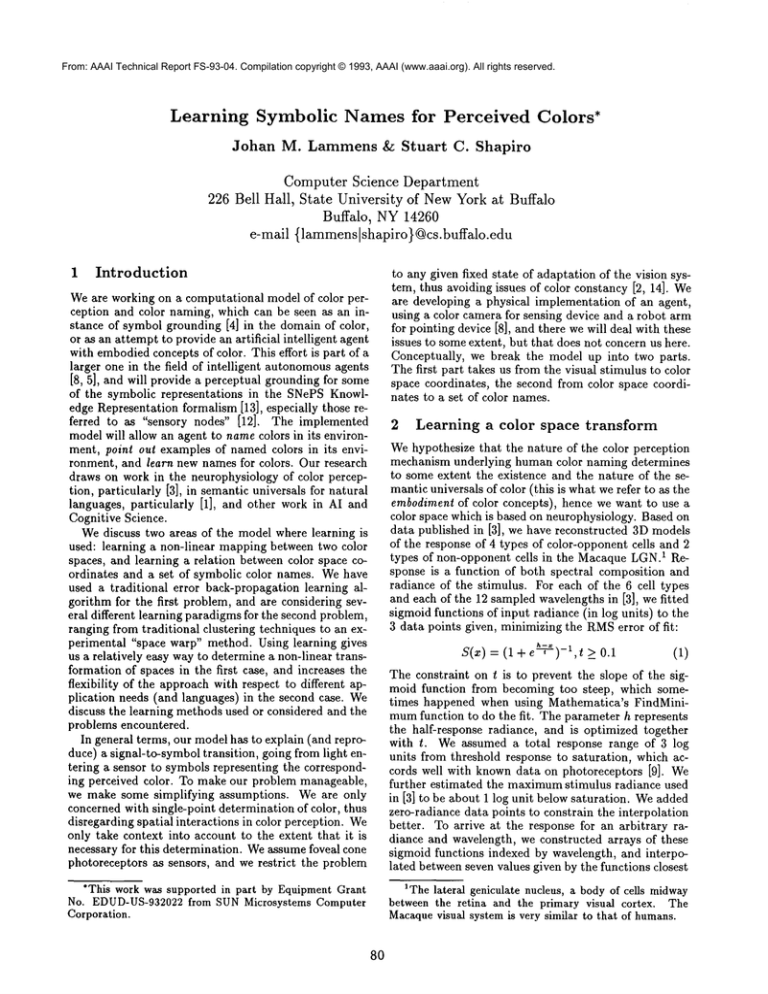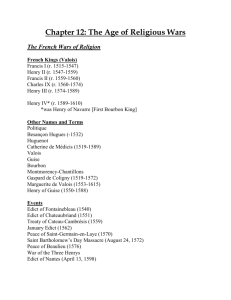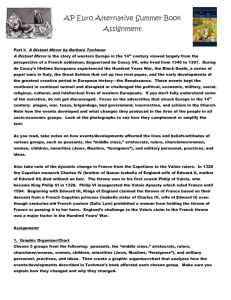
From: AAAI Technical Report FS-93-04. Compilation copyright © 1993, AAAI (www.aaai.org). All rights reserved.
Learning
Symbolic Names for Perceived
Johan
M. Lammens &= Stuart
Colors*
C. Shapiro
Computer Science
Department
226 Bell Hall, State University of New York at Buffalo
Buffalo,
NY 14260
e-mail { lammens Ishapiro } @cs.buffalo.edu
1
Introduction
Weare working on a computational model of color perception and color naming, which can be seen as an instance of symbol grounding [4] in the domain of color,
or as an attempt to provide an artificial intelligent agent
with embodiedconcepts of color. This effort is part of a
larger one in the field of intelligent autonomousagents
[8, 5], and will provide a perceptual grounding for some
of the symbolic representations
in the SNAPSKnowledge Representation formalism [13], especially those referred to as "sensory nodes" [12]. The implemented
modelwill allow an agent to name colors in its environment, point out examples of named colors in its environment, and learn new names for colors. Our research
draws on work in the neurophysiology of color perception, particularly [3], in semantic universals for natural
languages, particularly [1], and other work in AI and
Cognitive Science.
Wediscuss two areas of the model where learning is
used: learning a non-linear mapping between two color
spaces, and learning a relation between color space coordinates and a set of symbolic color names. Wehave
used a traditional error back-propagation learning algorithm for the first problem, and are considering several different learning paradigms for the second problem,
ranging from traditional clustering techniques to an experimental "space warp" method. Using learning gives
us a relatively easy wayto determine a non-linear transformation of spaces in the first case, and increases the
flexibility of the approach with respect to different application needs (and languages) in the second case.
discuss the learning methods used or considered and the
problems encountered.
In general terms, our modelhas to explain (and reproduce) a signal-to-symbol transition, going from light entering a sensor to symbols representing the corresponding perceived color. To make our problem manageable,
we make some simplifying assumptions. We are only
concerned with single-point determination of color, thus
disregarding spatial interactions in color perception. We
only take context into account to the extent that it is
necessary for this determination. Weassume foveal cone
photoreceptors as sensors, and we restrict the problem
*This work was supported in part by Equipment Grant
No. EDUD-US-932022from SUNMicrosystems Computer
Corporation.
to any given fixed state of adaptation of the vision system, thus avoiding issues of color constancy [2, 14]. We
are developing a physical implementation of an agent,
using a color camera for sensing device and a robot arm
for pointing device [8], and there we will deal with these
issues to someextent, but that does not concern us here.
Conceptually, we break the model up into two parts.
The first part takes us from the visual stimulus to color
space coordinates, the second from color space coordinates to a set of color names.
2
Learning
a color
space
transform
Wehypothesize that the nature of the color perception
mechanism underlying human color naming determines
to some extent the existence and the nature of the semantic universals of color (this is what we refer to as the
embodiment of color concepts), hence we want to use
color space which is based on neurophysiology. Based on
data published in [3], we have reconstructed 3D models
of the response of 4 types of color-opponent cells and 2
types of non-opponent cells in the Macaque LGN.1 Response is a function of both spectral composition and
radiance of the stimulus. For each of the 6 cell types
and each of the 12 sampled wavelengths in [3], we fitted
sigmoid functions of input radiance (in log units) to the
3 data points given, minimizing the RMSerror of fit:
S(z) = (1 e~-Ta)-l,t >_ 0.1
(1)
The constraint on t is to prevent the slope of the sigmoid function from becoming too steep, which sometimes happened when using Mathematica’s FindMinimumfunction to do the fit. The parameter h represents
the half-response radiance, and is optimized together
with t. Weassumed a total response range of 3 log
units from threshold response to saturation, which accords well with known data on photoreceptors [9]. We
further estimated the maximumstimulus radiance used
in [3] to be about 1 log unit below saturation. Weadded
zero-radiance data points to constrain the interpolation
better. To arrive at the response for an arbitrary radiance and wavelength, we constructed arrays of these
sigmoid functions indexed by wavelength, and interpolated between seven values given by the functions closest
1Thelateral geniculate nucleus, a body of cells midway
between the retina and the primary visual cortex. The
Macaquevisual system is very similar to that of humans.
8O
GR
Br
BY
°
o
0.5
-o_<._~’~mml/~°°
0"
0.6
6~400
1
GR
0.4
o.
I0¯(
0.8~.~400
1
1
DL
BY
0
)0
-0
0~400
o¯
o
0.~
o_%
30
0.4
)0
0.(
O.
)0
1
1
1
Figure 1: Basis functions for the Valois color space: directly modeledon physiological data (upper),
and the result of a learned XYZto Valois transform (lower). From left to right: Green-Red(GR),
Blue-Yellow (BY), and Brightness (Br). X axis: radiance in log units relative to the threshold
response; Y axis: wavelength; Z axis: activation¯
to the desired wavelength (using Mathematica’s standard 3rd order polynomial Interpolation). This gives us
the 6 reconstructed neural response functions. By pairwise adding these functions, we have derived new 3D
response functions that we take as the basis of an opponent color space: Green-Red and Blue-Yellow opponent functions and a non-opponent Brightness function
(Fig. 1, upper half). Wewill refer to this newly defined space as the Valois color space. Wehave reasons
to believe that existing opponent color models as used
in computer vision and computer graphics (for instance
[6]) are not accurate as models of color perception, but
we will not discuss that here.
Most work in Color Science [14] and color computer
vision is based on the CIE XYZcolor space and derivatives thereof, so we want a transformation from XYZ
coordinates to Valois space¯ Wealso need this to transform KGBcamera output to Valois coordinates¯ Since
we could not determine a linear transform between XYZ
and Valois which has a reasonable margin of error, we
used the error back-propagation algorithm to determine
such a transform, as commonlyused in artificial
neural
networks research [11]. In contrast with manyapplications of the backpropagation technique we did not use
the network as a classifier, but rather to learn three
simultaneous functions of three real variables. To construct a training set we made a regular grid of wavelengths and radiances and computed both XYZand
Valois coordinates for each point. The XYZcoordinates
functioned as inputs, the Valois coordinates as teaching
outputs. Wenormalized both the XYZand the Valois
coordinates to the [0, 1] range, which requires adding
an offset of 0.5 to the latter, since the original range
comprises both negative and positive numbers. The order of presentation of the training set was not varied.
The training set was linearized by concatenating seg-
81
ments corresponding to fixed radiances, in increasing
order of radiance. Someoptimizations were done for
momentum,temperature, and learning rate parameters.
Weexperimented with several network topologies: one,
two, and three layer with varying numbers of nodes in
the hidden layers. Wesettled on a 3 × 9 × 9 x 3 topology, loosely based on Kolmogorov’sresult (described in
[10]) that states that a three layer net with N(2N + 1)
nodes (not counting the input nodes) using continuously
increasing non-linearities
can compute any continuous
function of N variables, hoping that the same number
of nodes would suffice for three simultaneous functions
of three variables. After a large number of iterations
(up to 260,000 for a learning rate of 0¯03 and a training
set of 473 I/O vector pairs), this net convergedto a reasonable KMSerror of about 3%of the output range over
the complete training set. The transformation reduces
to an equation of the form
o -- s(M3. (s(M2¯ (s(M1¯ i)))))
(2)
where Mj represents the weight matrix for stage j, i
represents the vector of XYZinput coordinates, o the
vector of Valois output coordinates, and s represents the
usual sigmoid activation function, essentially the same
as equation 1. The result is shownin the lower half of
Figure 1.
Using the error back-propagation algorithm to learn
the transform is convenient since it is hard to determine
non-linear transforms in general, but it is not easy to determine the right morphology and other parameters of
the network for the particular problem at hand¯ There
was considerable trial and error involved in getting the
net to converge to a reasonable error level¯ The data
representation is also important in this respect¯ The
RMSerror measure is probably not the best possible
one to use to measure the goodness of fit, but we don’t
knowof a more useful one. As long as the weight matrices are square, the transform is invertible by computing
the inverse of the sigmoid activation function and of
the weight matrices, which then amountto linear transforms (this is not the case with the 3 × 9 × 9 × 3 topology
we used).
Nowthat we have defined the Valois space and a mapping into it from CIE XYZcoordinates, we can study
its properties with respect to the existing body of color
perception research, in addition to using it as a basis
for the naming part of our model. Wespeculate that
the Valois space is a good candidate for systematizing
and/or explaining experimental color perception results,
but at this point we have not yet investigated this any
further. Wecan derive measures for the psychophysical variables of hue, saturation, and brightness from the
Valois space.
3
Learning color names
For the second part of our model, relating Valois coordinates to a set of color names, we are experimenting
with a different kind of learning. Basically we need to
partition a 3D space into a set of volumes or regions,
each corresponding to a named color concept (or category). From a model-theoretical (logical) point of view,
we can consider these regions to be the extensional referents of the color terms involved. From the work of [1]
and others we know that there exists a set of semantic
universals in the domainof color, knownas basic color
categories (BCC), each corresponding to a "basic color
term" (BCT). Werestrict our attention to these. According to [1], they are categories of perception rather
than of language. Different languages may have lexicalized different numbers of these categories as basic
color terms, but nevertheless they are equally distinguishable and identifyable to speakers of any language.
Moreprecisely, the loci or "best examples" of the categories are universal, but there is some disagreement
about whether or not the extent (size) of the regions are
the same across languages. They speculate that these
categories reflect certain properties of the humancolor
perception mechanism, which are shared by all people
regardless of language. Wewant our naming algorithm
to learn the BCTsof a set of different languages (one
at the time) corresponding to (a subset of) the universal BCCs. Depending on the requirements we impose
on the shape of the BCCregions of our color space, we
can create binary valued or continuous valued "characteristic functions" for the regions, and have the regions
overlap or not. Wecould interpret the BCCsas fuzzy
sets [15, 7], for instance. Fromthe work of [1] and others we know that human BCCcharacteristic
functions
are continuous (or at least non-binary) valued, and that
the regions may or may not overlap, perhaps depending
on the particular experimental paradigm used.
From the literature (and partly from measurements)
we have estimates of the coordinates of the BCCfoci
in CIE XYZspace, and using the transform from Section 2 we can transform them into Valois space coordinates. There are several learning approaches we could
use to learn the relation between Valois coordinates and
BCTs. Wecould use error back-propagation again, but
82
we have chosen not to do so, because we consider other
approaches more revealing in this case. An alternative
might be to use well-known clustering techniques, i.e.
determining some kind of center of mass of a number of
input data points representing examples of a particular
category. Our work is still in an exploratory stage in this
area, but one of the approaches we favor is the following.
Assumingthat there are indeed particular properties of
the human color perception mechanism responsible for
the semantic universals, we are hoping that our Valois
color space captures those properties well enough to enable us to use them in a name learning algorithm which
would (very schematically) work as follows: 1) determine the Valois coordinates of the stimulus; 2) find the
nearest "distinguished location" in the space, 3) attach
the given name to that location. A naming algorithm
would work in a similar way: 1) determine the Valois
coordinates of the stimulus; 2) determine the nearest
named distinguished location; 3) return the name associated with it. A "distinguished location" in the color
space is one that stands out in one way or another,
in terms of the shape or properties of the space itself,
not in terms of the stimulus. There are two possible
sources of constraints on the location of BCTs:environmental and physiological. The environment determines
which surfaces and light sources are around, and hence
which visual stimuli can be perceived, and the physiology of color perception applies its own representations
and computations to the perceived stimuli. Given that
the physiology of perception has evolved in a particular
environment, it is likely attuned to the latter in some
way.
Wecan represent all physically possible surface spectral reflectance functions 2 in a solid knownas the Object Color Solid [14]. The surface of this solid represents
the limit of physically realizable surface colors, known
as the Optimal Color Stimuli, and can be generated by
computing the response of a given set of sensors to a
continuumof a particular kind of artificial spectra. Assuming a flat-spectrum light source (with a spectrum
given by c~(~) = 1), we have computed the shape of
surface of the OCSsolid. Fig. 2 represents the Optimal Color Stimuli surface in CIE XYZ,CIE L*a*b* and
the Valois color space. Note the different shapes of the
solid, and how it is "warped" in the L*a*b* and Valois
spaces, relative to XYZ.Because of the non-linearities
in the Valois model, the shape of the surface changes
with changing radiance of the stimuli, which is not the
case for the other two color spaces. The OCSsurface in
the Valois space is displayed for a relative radiance of
0.66, or ~ of the maximum.
To investigate the warpedness of the Valois space, we
used a crude measure of how the local density of the
space has changed with respect to the corresponding
region in the XYZspace, computing the ratio of a volume in XYZspace to the volume of its image in Valois
2Or transmittance functions, which makes no difference
for our purpose.
Figure 2: The Optimal Color Stimuli solid in
the CIE XYZspace (left), the CIE L*a*b* space
(middle) and the Valois space (right). On
X,Y,Z axes (arbitrary units): CIE X,Y,Z coordinates; CIE a*,b*,L* coordinates; Valois GreenRed, Blue-Yellow, and Brightness coordinates.
Figure 5: Spacing of the basic color categories
in the Valois space varies with radiance. From
left to right: relative radiance of 0.33, 0.66, and
0.99.
space:
w(r)
E, p
3
1
(c,
(3)
where P is a set of points around the reference point r
for which the function value is computed (we used six
points equidistant from the reference, along the three
Valois axes), d ranges over the dimensions of the space:
Green-Red, Blue-Yellow, and Brightness, f is the function that transforms XYZto Valois, Cd is the d-th coordinate of point i E P, and Crd is the d-th coordinate
of the reference point r. 3 This doesn’t actually measure a volume of course, but the bigger the set P is,
the better the approximation will be. A large set of
random points in a sphere around r would probably
work best. If w(r) < 1 the Valois region around r
expanded relative to XYZ,if w(r) > 1 the region
shrunk, and if w(r) = 1 it is unchanged. Figure 3 shows
some contour plots of w at planes of constant Brightness value. 4 Weare still investigating the relation of
the warpedness of the Valois space to the spacing of basic color categories. For somepreliminary observations,
consider Figure 4. The locations and relative spacing
of the (foci of) the 11 basic color categories for English
(white, black, red, green, yellow, blue, brown, purple,
pink, orange, grey) after Von Kries adaptation are different in the different color spaces. Wehave to analyze
the data further in the hope of discovering some interesting properties of this spacing, e.g. with respect to
saturation or other psycho-physical measures. Because
of the non-linearities in the XYZto Valois transform,
the spacing actually varies with radiance in the Valois space (Figure 5). Note how the categories near the
far upper left corner (e.g. white, yellow, and pink) get
squeezed together as radiance increases. In psychophysical terms that means amongother things that their saturation decreases and they becomeincreasingly difficult
to distinguish from each other, which accords well with
visual experience (at very high relative radiance levels
everything tends to look white, for instance whenstepping out into the bright mid-day sunlight after working
all night long on a paper in a dark windowless dungeon
- a.k.a, office). Noneof the other color spaces currently
in use have this property, to our knowledge. It may explain the well-known hue shifts with changing radiance
too (the Bezold-Br/icke effect), but this remains to
investigated in detail.
4
Discussion
and
conclusion
Wehave presented two areas in our work where learning
is or can be used: learning a transform from one color
space to another, and learning namesfor basic color categories. In the first case we used an error backpropagation method to learn a non-linear transform with reasonable success, in the second case we are investigating
a "space warp" learning method. Both procedures are
part of our signal-to-symbol transformation going from
visual stimuli to symbolic color names. The advantage
of the backpropagation learning is that it allows us to
determine a nonlinear transform which would be hard to
do otherwise. The main advantage of learning the color
space to color names relation is that it allows flexible
adaptation of the modelto different tasks, e.g. different
languages.
References
[1] B. Berlin and P. Kay. Basic Color Terms: Their
Universality and Evolution. University of California Press, Berkeley CA(1991 edition), 1969.
[2] R. M. Boynton. HumanColor Vision. Holt, Rinehart and Winston, 1979.
[3] R. L. De Valois, I. Abramov, and G. H. Jacobs.
Analysis of response patterns of LGNcells. Journal
of the Optical Society of America, 56(7):966-977,
July 1966.
[4] S. Harnad. The symbol grounding problem. Physica D, 42(1-3):335-346, 1990.
[5] H. Hexmoor, J. Lammens, and S. Shapiro. Embodiment in GLAIR: A grounded layered architecture with integrated reasoning for autonomous
agents. In D. D. Dankel, editor, Proceedings of the
6th Florida AI Research Symposium, pages 325329. Florida AI Research Society, 1993.
3This assumes that that f is a topological transform,
which is a reasonable assumption to make.
4Unfortunately, Mathematicadoes not have Jello graphics built-in. A 3DJello solid with locally varying density
or color could be used to visualize the warpfunction values
over the entire space at a glance.
83
Figure 3: Somecontour plots of the warp function w at constant Brightness values of 0, 0.2, 0.4,
and 0.6 (see text). X axis: GR, Y axis: BYValois dimension. Lighter color means higher values
(greater warp), black areas represent non-real valued areas of f-1.
Figure 4: Location of the 11 Basic Color Categories for English relative of the Optimal Color
Stimuli surface in XYZ, L*a*b*, and Valois spaces. (The dots inside the wire frame volumes
are actually colored according to the basic color category they represent. The online PostScript
version of this paper is in color; it is available from AAAIor by anonymousftp to ftp.cs.buffalo.edu
(128.205.38.1) in pub/tech-reports, or from the waters server on wais.)
[6] D. Jameson and L. M. tturvich. Somequantitative
aspects of an opponent-colors theory: I. chromatic
responses and spectral saturation. Journal of the
Optical Society of America, 45(7):546-552, 1955.
[7] P. Kay and C. K. McDaniel. The linguistic significance of the meaning of basic color terms. Language, 54(3):610-646, 1978.
[8] J. M. Lammens, It. H. Hexmoor, and S. C.
Shapiro. Of elephants
and men. In Proceedings of the NATOASI on Intelligent
Autonomous
Agents (Trento, Italy). Springer Verlag (To appear.
Preprint available as CS TR-93-13, SUNY/Buffalo
[anonymous@ftp.cs.buffalo.edu:/pub/techreports]).
[9] K. N. Leibovie. Vertebrate photoreceptors. In K. N.
Leibovic, editor, Science of Vision, chapter 2, pages
16-52. Springer, NewYork, 1990.
[10] G. G. Lorentz. The 13th problem of Hilbert. In
F. E. Browder, editor, Mathematical Developments
Arising from Hilbert Problems. American Mathematical Society, 1976.
84
[11] D. E. Rumelhart, G. E. Hinton, and R. J. Williams.
Learning internal representations by error propagation. In D. Rumelhart, J. McClelland, and the
PDPResearch Group, editors, Parallel Distributed
Processing, chapter 1, pages 319-362. MITPress,
Cambridge MA, 1986.
[12] S. C. Shapiro and W. J. Rapaport. SNePSconsidered as a fully intensional propositional semantic
network. In N. Cercone and G. McGalla, editors,
The knowledge frontier: essays in the representation of knowledge, pages 262-315. Springer, New
York, 1987.
[13] S. C. Shapiro and W. J. Rapaport. The SNePS
family. Computers Math. Applic., 23(2-5):243-275,
1992.
[14] G. Wyszeckiand W. S. Stiles. Color Science. Wiley,
NewYork, 1982.
[15] L. A. Zadeh. Quantitative fuzzy semantics. Information Sciences, 1971.





![Pre-class exercise [ ] [ ]](http://s2.studylib.net/store/data/013453813_1-c0dc56d0f070c92fa3592b8aea54485e-300x300.png)



